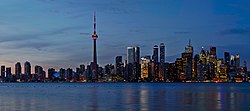| Greater Toronto and Hamilton Area | |
|---|---|
| Conurbation | |
 Downtown Toronto Downtown Toronto | |
| Nickname: GTHA | |
 | |
| Country | |
| Province | |
| Area | |
| • Total | 8,244.42 km (3,183.19 sq mi) |
| Population | |
| • Total | 7,281,694 |
| • Density | 844/km (2,216/sq mi) |
| Combined population of the cities of Toronto and Hamilton and the regional municipalities of Halton, Peel, York, and Durham | |
| GDP | |
| • Total | CA$514.832 billion US$410.733 billion (2021) |
| Time zone | UTC-5 (EST) |
| • Summer (DST) | UTC-4 (EDT) |
| Postal Code | L, M |
| Area code(s) | 226, 519, 548, 416, 437, 647, 249, 705, 905, 289, 365 |
The Greater Toronto and Hamilton Area (GTHA) is an urban conurbation that is composed of some of the largest cities and metropolitan areas by population in the Canadian province of Ontario. The GTHA consists of the Greater Toronto Area (GTA) and the City of Hamilton. Unlike the Golden Horseshoe, which covers a larger area, the GTHA specifically refers to the urban conurbation of these regions. Despite not being in the conurbation's name, it also includes the City of Oshawa and its sub-metropolitan area. The GTA is Canada's most populous metropolitan area that includes the core City of Toronto and the regional municipalities of Halton, Peel, York, and Durham (which contains Oshawa). The GTHA forms the core of a larger urban agglomeration known as the Golden Horseshoe.
Beginning in the late-2000s, the term "Greater Toronto and Hamilton Area" was introduced by a few public bodies to refer to the GTA and the city of Hamilton as a single entity. The population of the combined area is 7,281,694 as of 2021, and is projected to grow to 8.6 million by 2031. The main series of roadways that connects all the areas together (going from Durham to Hamilton) includes highways 401, 427, 403, and the Queen Elizabeth Way. The GTHA has regional public transport served by GO Transit and local service by multiple agencies, which mostly use the Presto card as fare payment.
Municipalities and populations
| Census division | Population (2016) | Population (2021) | Change |
|---|---|---|---|
| Toronto | 2,731,571 | 2,794,356 | +2.30% |
| Hamilton | 536,917 | 569,353 | +6.04% |
| Halton | 548,435 | 596,637 | +8.79% |
| Peel | 1,381,739 | 1,451,022 | +5.01% |
| York | 1,109,909 | 1,173,334 | +5.71% |
| Durham | 645,862 | 696,992 | +7.92% |
| Greater Toronto and Hamilton Area | 6,954,433 | 7,281,694 | +4.71% |
See also
Footnotes
- Adopters include the regional transportation planning body Metrolinx, the Ministry of Energy and Infrastructure and the Regional Municipality of Halton.
References
- "Gross domestic product (GDP) at basic prices, by census metropolitan area (CMA)". Statistics Canada.
- "Focus on Geography Series, 2021 Census of Population: Oshawa, Census metropolitan area". Statistics Canada. Retrieved 2024-08-19.
- "About Us". Metrolinx Website. Metrolinx. Archived from the original on 2010-05-05. Retrieved 2011-02-10.
- "Places to Grow: Growth Plan for the Greater Golden Horseshoe" (PDF). Ministry of Public Infrastructure Renewal. 2006. p. 9. Archived from the original (PDF) on 2011-07-06.
- "Amendment No. 38 to the Regional Plan (2006)". Regional Municipality of Halton. 2009-12-16. Archived from the original on 2011-07-06. Retrieved 2011-02-10.
- ^ Government of Canada, Statistics Canada (2022-02-09). "Select from a list of geographies - Ontario". www12.statcan.gc.ca. Retrieved 2022-02-10.
- "The Big Move". Metrolinx. 2008. Retrieved 2014-03-12.
43°40′N 79°25′W / 43.667°N 79.417°W / 43.667; -79.417
Categories: